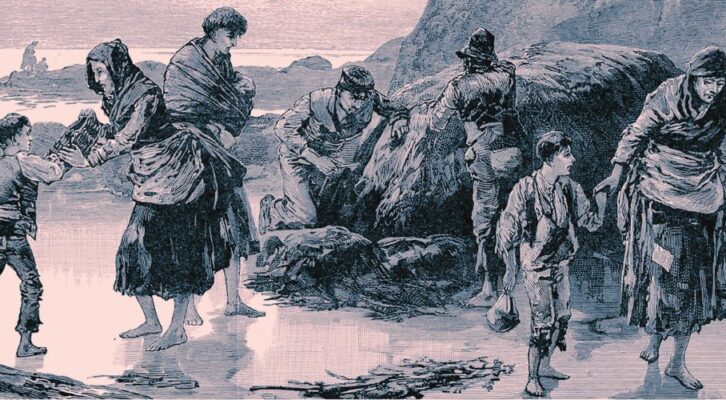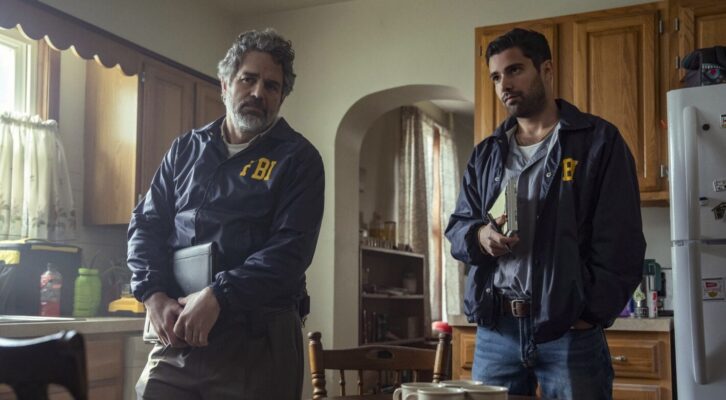
An Immodest Proposal: How Britain’s Relentless Imperialism Created the Irish Potato Famine
Padraic X. Scanlan on Jonathan Swift, Colonization, and Dispossession
In the eighteenth century, Ireland was roughly eighty percent Catholic, but only five percent of Irish land was owned by Catholic landlords. Dispossession, reinforced by laws forbidding Catholic participation in political and economic life, were key features of British colonialism in Ireland.
Colonization had a long history. In the twelfth century, Norman soldiers invaded Ireland, extending the Norman Conquest of England across the Irish Sea.
After the invasion, the new Anglo-Norman nobility was all but independent until King Henry VII reimposed English government and limited the Irish Parliament’s authority after his victory in the Wars of the Roses (1455–1487). In 1541, after a failed rebellion led by the Earl of Kildare against the Crown, Henry VIII declared himself king of Ireland as well as England.
From the 1540s on, the Crown experimented with the colonization of Ireland by English, Welsh, and Scottish settlers. These “plantations”—meant in the sense of a grove of trees planted to birth a forest—were supposed to pacify Ireland through gradual Anglicization. The first plantations in Munster crumbled.
But in the early seventeenth century, with the support of King James I, six counties in the northern province of Ulster—Donegal, Tyrone, Fermanagh, Cavan, Armagh, and Londonderry—were cleared of many Catholics by force and resettled by English and Scottish Protestants. A seventh county, Antrim, was settled “privately” by independent Protestant settlers with the Crown’s tacit endorsement.
Dispossession, reinforced by laws forbidding Catholic participation in political and economic life, were key features of British colonialism in Ireland.
Throughout the eighteenth and nineteenth centuries, the majority-Protestant “Ulster Plantation” (six counties of which now compose Northern Ireland) was often a relatively more prosperous exception to the poverty of the other provinces. On the eve of the English Civil Wars of the 1640s, there were one hundred thousand Protestant settlers in Ireland—some thirty thousand Scots and seventy thousand Welsh and English. Although outnumbered fifteen to one by Catholics, Protestants already owned more than forty percent of Irish land.
In 1641, during the Civil Wars, the Irish Catholic nobility rebelled and won de facto independence. But from 1649 to 1651, after the defeat of the Royalists and the execution of King Charles I, Oliver Cromwell—the leading figure in the army raised by Parliament and Lord Protector of England from 1653—launched a ruthless reconquest of Ireland.
Historians question the degree to which Cromwell personally intended to exterminate Catholics, although some of his followers considered the invasion of Ireland a holy war. Reports of massacres of Protestants fueled the fire. Irish Catholics, one pamphlet declared, “are the very offal of men, dregs of mankind, reproach of Christendom….Cursed be he that maketh not his sword stark drunk with Irish blood.”
In 1652, many Catholics were formally stripped of their land by act of Parliament and driven from their homes to the western province of Connaught, designated as the new home of the “native” Irish. Catholic priests were executed. Many Irish soldiers fled the island to join the French and Spanish armies; thousands who were captured were sent as indentured laborers to England’s Caribbean colonies.
The humiliation and trauma of the invasion made Cromwell a figure of mythic evil in Irish folk memory. In one story, Cromwell punished a soldier who stole milk by stabbing the thief in the stomach, “out of which spurted the milk…a warning that none of his soldiers could do anything without his permission.”
After Oliver Cromwell’s death, the Commonwealth collapsed, and in 1660 Charles II was restored to the throne (Cromwell’s corpse was exhumed, put on trial, and convicted of treason). Two years later, select Irish Catholic landowners who had remained loyal to the Crown were restored to their lands. In 1685, Charles died.
His brother, James, was Catholic. However, James was in his fifties, and his heir, Mary, firmly Protestant, was married to William of Orange, stadtholder of the Netherlands and a stalwart of the Dutch armed struggle against Spain, one of Europe’s great Catholic monarchies.
James was crowned James II with the grudging consent of Parliament. All but the hottest Puritans conceded that the accession of an older Catholic king with a Protestant heir was better than renewed war.
In power, James edged toward restoring all Catholic land in Ireland. In 1687, the Catholic Earl of Tyrconnell was appointed lord lieutenant and persuaded James II to annul the laws prohibiting the partial return of land to “innocent” Catholics. Anticipating that the Cromwellian settlement would be overturned, Protestant landowners fled. Paramilitaries in Ulster armed themselves.
In 1688, James’s wife, Mary of Modena, gave birth to a son whose claim to the throne would trump that of his Protestant half sister. A Catholic king was tolerable; a Catholic dynasty was not.
A group of leading MPs secretly invited James’s son-in-law, William of Orange, to take the English throne. In November 1688, William landed in England at the head of an army. James II fled, and William was crowned William III in 1689, ruling as co-monarch with the deposed king’s daughter, now Mary II.
As the gap between the British and Irish economies grew, the idea of the Irish as insinuating papists at best and ungovernable barbarians at worst solidified in British popular culture.
In England, the 1688 invasion was a “Glorious Revolution.” In Ireland, it began a new war of conquest. When William’s army drove James II from England, he fled first to Ireland, where many Catholic aristocrats rallied around his cause. William invaded Ireland, personally leading his troops against an army led by James, at the Battle of the Boyne in 1690—one of the last European battles in which two monarchs faced each other on the battlefield.
England tightened its grip on Ireland, and the persecution of Irish Catholics continued. In 1707, England and Wales merged with Scotland, formerly a separate kingdom (although under a single Crown), to form Great Britain.
The new British Parliament, following on laws passed under Cromwell, passed a series of acts, known as the Penal Laws, to persecute Irish (and British) Catholics. Catholics had been barred from all public offices in Ireland since 1607, and in 1707 the ban was extended to Presbyterians. Catholics were forbidden to marry Protestants, and they could not sit in either the English or the Irish Parliament or vote in elections.
Catholics were barred from many professions. Catholicism assumed a “catacomb existence.” Although Catholics were the majority even in Ulster, by the nineteenth century there were only 2,015 Catholic churches serving Ireland’s 6.5 million Catholics. Priests would travel, sometimes in secret, on “stations,” going out twice a year to hear confession and say Mass in private homes.
The Penal Laws against Catholic rites were often indifferently enforced in Ireland, but the laws that disinherited and dispossessed Catholic landlords were scrupulously followed. The heirs of Catholics could inherit land only if they converted to the Anglican church, and no Catholic could inherit land owned by a Protestant. Any landlord who converted to Catholicism forfeited his property to the Crown and faced an indefinite prison term.
Some two thousand landowners, many descendants of Cromwell’s and William’s soldiers and allies, owned virtually all of Ireland’s arable land, some in estates larger than fifty thousand acres. Protestant landlords, however, depended on the despised Catholic majority for rent and labour.
As the new state of Great Britain consolidated, the British Empire grew. Ireland was largely shut out of trade to Britain, so Irish merchants sent most of their goods across the Atlantic, with eighty-five percent bound for the Caribbean colonies.
A cargo of Irish linen, for example, might go to Barbados to be sold for sugar, with the sugar taken to England to be sold for cash. The risks of this attenuated trading network raised the cost of borrowing for Irish merchants, who both paid more for credit and earned less on exports.
Meanwhile, Irish landlords collected rent on estates that some rarely, if ever, visited. William Petty, the English polymath who served Cromwell, Charles II, and James II, noted that as early as 1664, at least twenty-five percent of Irish landlords lived in England, where “all that belongs to them goes out, but returns not.”
As the gap between the British and Irish economies grew, the idea of the Irish as insinuating papists at best and ungovernable barbarians at worst solidified in British popular culture. Jonathan Swift’s famous satire, “A Modest Proposal,” published in 1729, skewered both the poverty of the Irish countryside and an already well-defined contempt for the Irish in Britain.
In the essay, Swift proposed the slaughter of Irish children, “plump, and fat” as a solution to Irish poverty. “A child will make two dishes at an entertainment for friends, and when the family dines alone, the fore or hind quarter will make a reasonable dish,” Swift wrote. “I grant this food,” he continued, “will be somewhat dear, and therefore very proper for landlords, who, as they have already devoured most of the parents, seem to have the best title to the children.”
Swift was revolted both by Irish poverty and by the willingness of Britons to think of the Irish as not only poor but feral, cannibal, subhuman.
______________________________

Rot: An Imperial History of the Irish Famine by Padraic X. Scanlan is available via Basic Books.
Padraic X. Scanlan
Padraic X. Scanlan is an associate professor at the Centre for Industrial Relations and Human Resources and the Centre for Diaspora & Transnational Studies at the University of Toronto. His writing has appeared in The Washington Post, The Guardian, The Times Literary Supplement, and The New Inquiry. The author of Rot: An Imperial History of the Irish Famine and two previous books, he lives in Toronto.



















